JBL Quantum 910X review: great gaming audio, but some rough edges
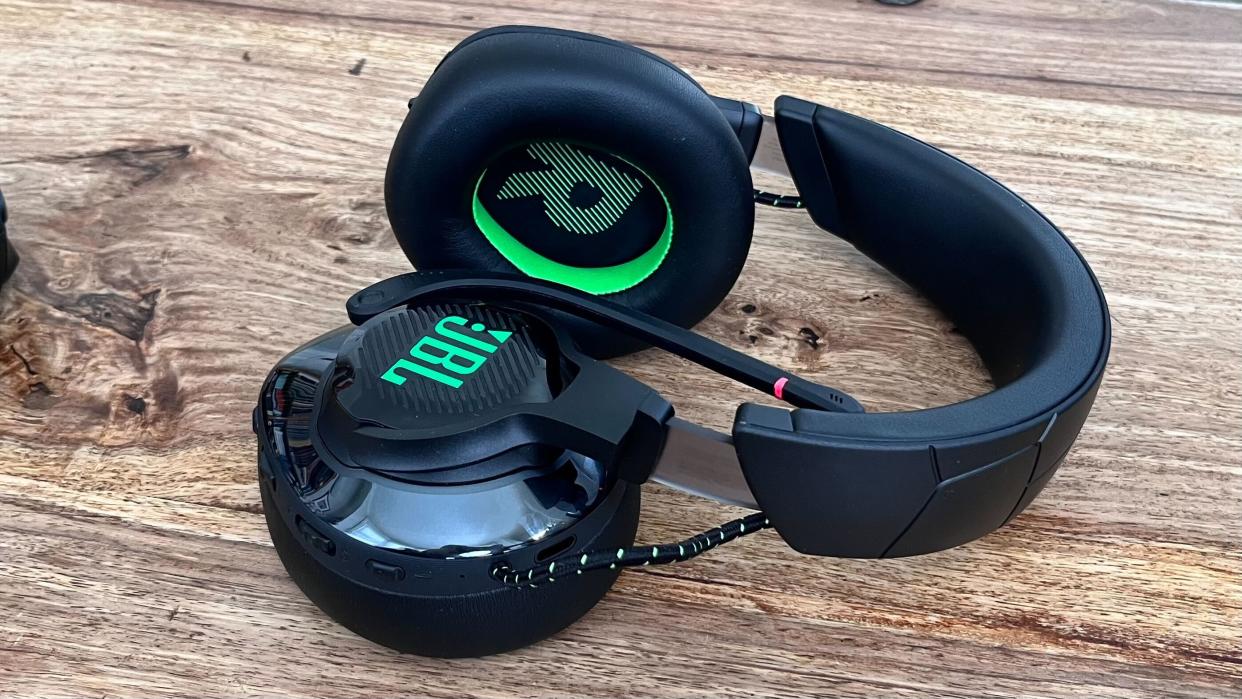
One-minute review
A high-end wireless gaming headset designed for Xbox, the JBL Quantum 910X falls just short of earning a place among the best Xbox Series X headsets. That’s not to say that it isn't still a formidable option, however, as it offers an excellent level of comfort that’s backed up by rich audio; it’s absolutely perfect for many of the best Xbox Series X games. In addition to Xbox, it’s also fully compatible with PlayStation, Nintendo Switch, and PC, making it a strong multi-platform choice.
Unfortunately, the flagship feature of the JBL Quantum 910X, its head-tracking 360 degree spatial audio, is a mixed bag. The head-tracking itself is exceptional, simulating your head motion perfectly, but the audio quality takes a substantial hit whenever the feature is enabled. The bass becomes almost non-existent, completely ruining the punchy action of first-person shooter (FPS) titles like Call of Duty: Modern Warfare 3, while the high end frequencies sound sharp and unpleasant. If your number one concern is high-quality spatial sound, no shortage of cheaper headsets like the SteelSeries Arctis Nova 7X, offer far superior spatial audio.
The microphone is the only other major area where the JBL Quantum 910X falls behind the competition. It lacks adjustability and leaves your voice sounding grainy and quiet. It’s by no means unusable, but this is nowhere near the level of performance that you would reasonably expect for this price. Whether this is the headset for you is therefore going to depend on whether these two shortcomings are a total deal breaker but, if they’re not, there’s still an awful lot to like here.
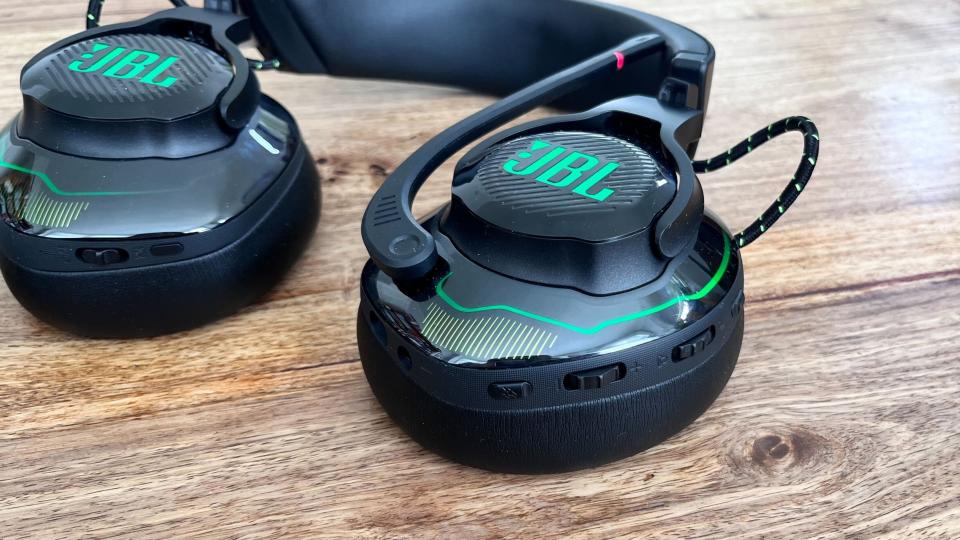
Price and availability
$299.95 / £219.99
Available in the US and UK
Better value in the UK
The JBL Quantum 910X costs $299.95 / £219.99 and is available in the US and UK directly from JBL or at retailers like Amazon. In the US, this comes in slightly cheaper than other high-end gaming headsets, such as the $329.99 / £279.99 Turtle Beach Stealth Pro, but is still firmly in premium territory. All things considered, it’s quite a reasonable price when you factor in the presence of high-end features such as active noise cancellation, not to mention customizable RGB lighting and the robust build quality.
Even so, UK price represents the best value of the two regions. At £219.99, the headset is a massive £60 less expensive than the Turtle Beach Stealth Pro, widening the gap between the two headsets and making the JBL Quantum 910X a much more tempting proposition.
Unfortunately, the JBL Quantum 910X is not currently available in Australia.
Specs
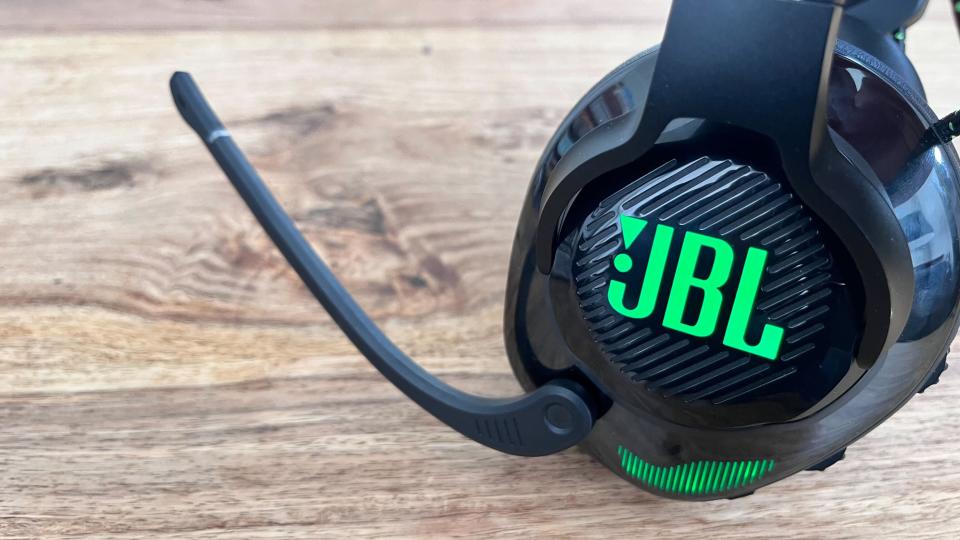
Design and features
The exterior of the JBL Quantum 910X is primarily constructed from a smooth black plastic. Its ear cups are covered in bright RGB lighting, illuminating in a ring around each ear in addition to an area with a small grill-like pattern and a prominent embossed JBL logo. The lighting is set to green by default which is perfect if you intend to use the headset with an Xbox out of the box. This lighting can be fully customized through the compatible JBL Quantum Engine software on a PC.
Each ear cup is connected to the headband with a clear plastic strip and a short braided cable, which is black with subtle green stripes. The clear plastic portion can be extended or retracted in order to customize the fit, engraved with numbers that indicate different sizing settings. The ear cups themselves then use soft black pleather cushions, which are a generous size and pleasantly soft.
The same cushioning is also found on the underside of the headband itself, which is topped with black plastic covered in a tactile grooved design. Although the JBL Quantum 910X is notably heavier than many other gaming headsets, weighing a hefty 14.8oz / 420g, the comfortable cushions makes it surprisingly easy to wear for extended periods without discomfort.
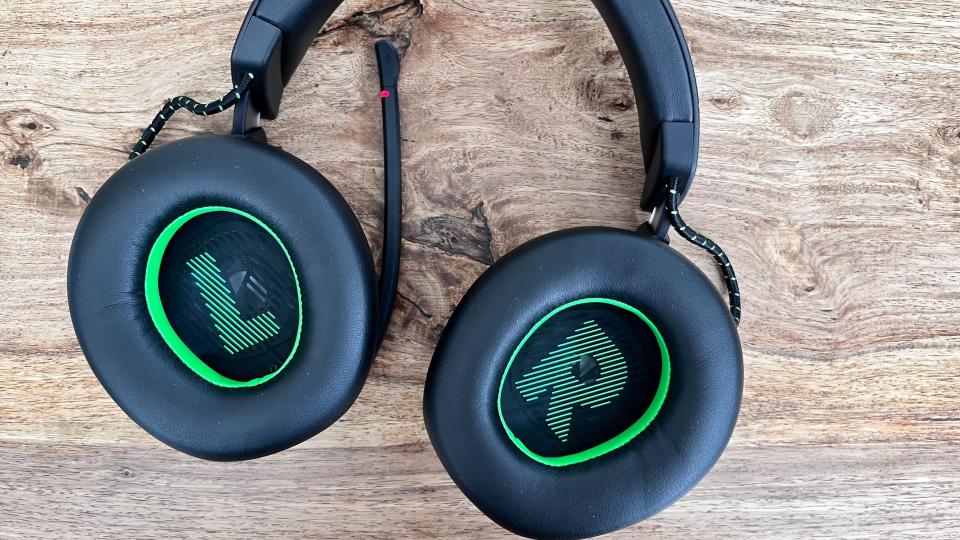
The microphone is attached to the left ear cup and can be raised or lowered. It’s muted by default in its raised position, indicated by a small red LED light near its tip. There’s also a separate dedicated microphone mute button on the back of the ear cup, which is handy if you want to quickly mute the microphone without having to raise it. This is positioned below a volume dial, a volume mixer dial (which changes the balance between in-game audio and audio from a connected mobile phone), and a switch which enables or disables the headset’s active noise cancellation. On the bottom of the left ear cup you will also find the USB Type-C port, which can be used for both charging and wired play. It’s next to a 3.5mm headphone jack and superb braided cables for both are included in the box.
Controls on the right ear cup are simpler, with a power slider that doubles as a switch to enable Bluetooth connectivity and a simple button that alternates between standard audio, spatial sound, and full head-tracking. Although it can be used out of the box, spatial sound can be further calibrated for enhanced precision in the JBL Quantum Engine software.
This is a simple process with clear on screen instructions, but does require an included detachable microphone to sit in your ear. Factor in the wireless dongle, which comes alongside a compact USB Type-A to USB Type-C converter and that’s a lot of separate accessories to keep track of. Luckily, the headset comes with an absolutely lovely plush gray bag which is perfect for keeping everything in one place.
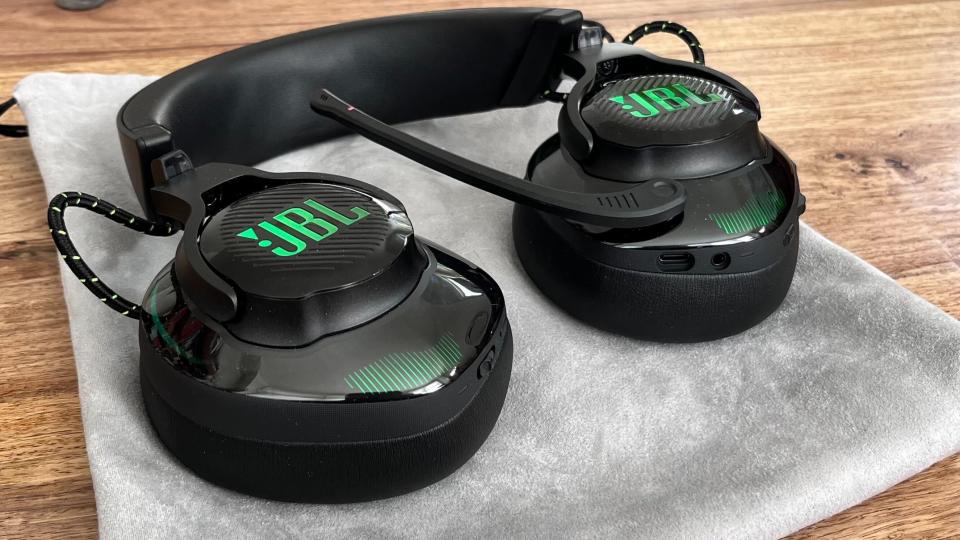
Performance
In its standard mode, the JBL Quantum 910X performs excellently on the whole. It offers punchy, rich bass, clear mids, and detailed high-end frequencies. While its overall audio profile might be a little too bass-heavy for audiophile music listening, it’s absolutely perfect for gaming and the range of titles I tested sounded superb. Shots in Call of Duty: Modern Warfare 3 packed some serious punch on Xbox Series S, while the streets of Sotenbori in the PC version of Like a Dragon Gaiden: The Man Who Erased His Name felt impressively life-like.
The emphasis on bass is also an excellent fit for rhythm games and I enjoyed quite a bit of success challenging myself with “JITTERBUG” on Extreme difficulty in Hatsune Miku: Project DIVA Future Tone on PS5. The JBL Quantum Engine software offers a range of useful equalizer modes and is, on the whole, some of the best companion software that I’ve ever tested. It offers an impressive number of functions, features an intuitive and attractive UI, and is lightning fast while taking up just 255MB of space. A mobile app or a native application for Xbox would enable those without access to a PC to benefit from its features, but otherwise there is nothing to complain about here.
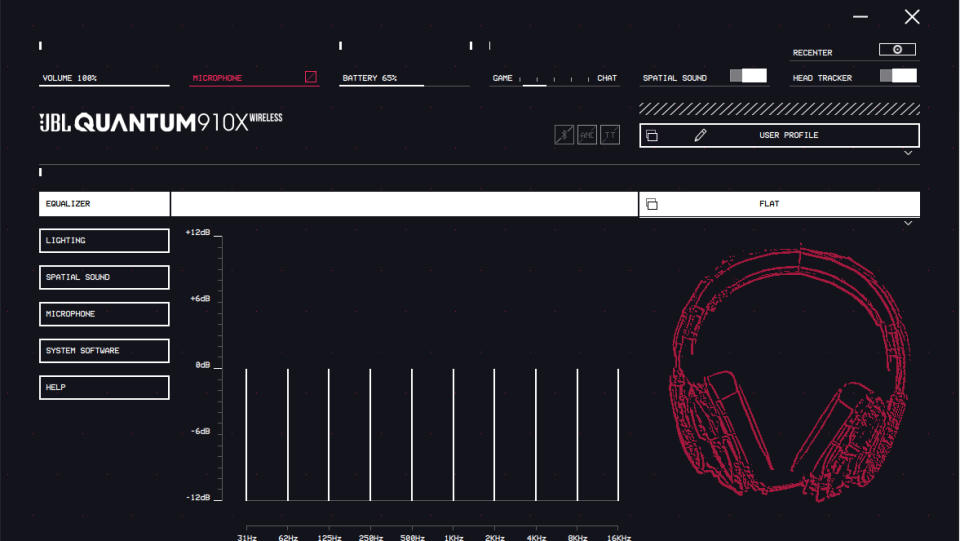
Returning to the headset, the on-board controls are well-spaced and responsive, while the active noise cancellation is a treat. It’s very effective and managed to block out almost everything that I could throw at it, ranging all the way from nearby conversations to loud passing vehicles. I also consistently managed to squeeze an impressive 32 hours of battery life out of the headset, which was more than enough for a full week of gaming sessions.
Unfortunately, the performance with the spatial audio mode enabled is a completely different story. The illusion of depth is there, but the bass instantly vanishes leading to an incredibly tinny sound that lacks any impact whatsoever. It’s like listening to a tiny pair of cheap speakers in a massive hall, an impression that is only further reinforced by the oddly echoey sound of any dialogue.
The optional head tracking, which sees the audio source shift as you look around, is incredibly accurate and well worth experimenting with for a few minutes, but the dramatic fall in audio quality means that it’s impossible to recommend using the spatial audio mode for any substantial length of time which is a huge shame.
The microphone performance is also disappointing. The physical microphone itself is unusually rigid and cannot be adjusted to be closer or further away from your mouth very easily. I found that this meant that my voice often sounded rather quiet and a little muddy. I was still easy to understand, once every participant of my calls had adjusted their volume accordingly, but this really shouldn't be necessary with such an expensive peripheral.
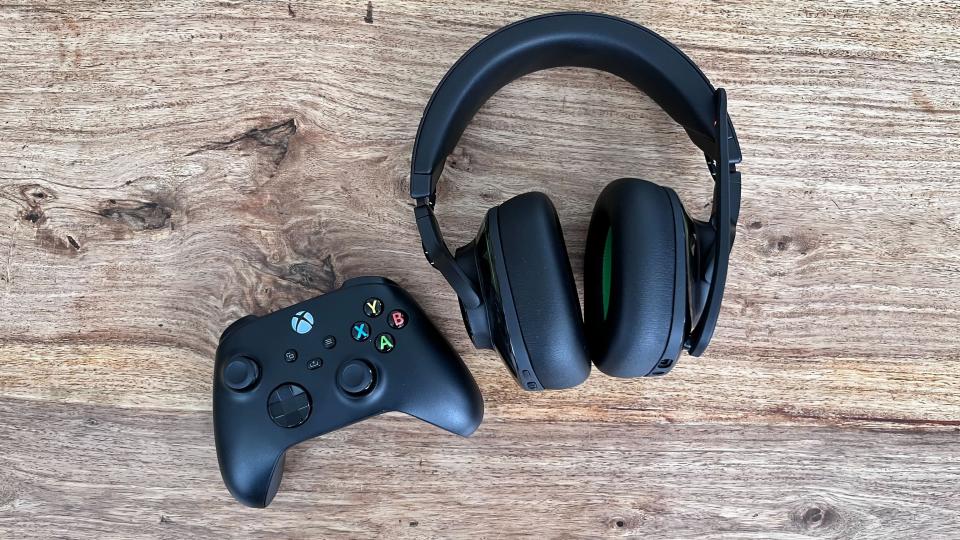
Should I buy the JBL Quantum 910X?
Buy it if...
Don't buy it if...
Also consider
If you’re not keen on the JBL Quantum 910X, you should consider these two compelling Xbox-compatible alternatives instead.
How I tested the JBL Quantum 910X
Used daily for over a month
Tested with a wide range of platforms
Compared to other premium gaming headsets
I tested the JBL Quantum 910X for over a month, using it as my main gaming headset. During that time, I tested the headset with Xbox Series S, PlayStation 5, PC, and Nintendo Switch playing a broad range of titles. In addition to my usual favorites, I tried to focus on some modern games that offer rich sound, including the likes of Counter-Strike 2, Need for Speed Unbound, The Last of Us Part 2 Remastered, and Fortnite. In order to test the microphone, I used the headset for multiple online gaming sessions and recorded a number of audio files with Audacity.
Throughout my time with the headset, I was careful to compare the experience with my hands-on time with other high-end gaming headsets such as the SteelSeries Arctis Nova 7X, Astro A50 X, and Turtle Beach Stealth Pro .
First reviewed April 2024

